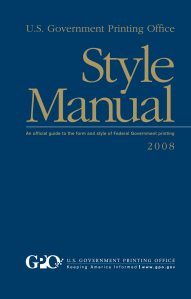 As I mentioned some months ago, 2011 marks the U.S. Government Printing Office’s 150th anniversary. Since no history of the agency has been written since 100 GPO Years in 1961, and a great deal has happened to both GPO and the Nation since then, Keeping America Informed: The U.S. Government Printing Office, 150 Years of Service to the Nation is a welcome addition to a relatively sparse collection of books on the subject. (Full disclosure: I was a member of the editorial group that worked on this book and I wrote several of the sidebars scattered throughout – whew, glad to get that off my chest!)
As I mentioned some months ago, 2011 marks the U.S. Government Printing Office’s 150th anniversary. Since no history of the agency has been written since 100 GPO Years in 1961, and a great deal has happened to both GPO and the Nation since then, Keeping America Informed: The U.S. Government Printing Office, 150 Years of Service to the Nation is a welcome addition to a relatively sparse collection of books on the subject. (Full disclosure: I was a member of the editorial group that worked on this book and I wrote several of the sidebars scattered throughout – whew, glad to get that off my chest!)
Perhaps because GPO still is at its original location at the corner of North Capitol and H Streets Northwest, just down the street from the U.S. Capitol, it has a remarkable collection of photographs of its buildings, equipment, and especially people. Those photographs really make this new book something special. It’s impressive and oddly moving to see the printers of a century ago gazing solemnly at the camera, “getting the books out” just as we do here today. For many readers, these images will put a human face on a little-known but vital aspect of the Government.
The text is impressive, too. In the 50 year since the last GPO history was published, a lot has happened. There are triumphs (the transition from hot metal to computer typesetting, the advent of the digital age and the Internet, GPO Access and the Federal Digital System) and frank discussions of controversial matters (the McCarthy era investigations of GPO, the 1968 riots that disrupted nearby neighborhoods). There is also more information on aspects of the more distant past, such as GPO’s reluctant role in Theodore Roosevelt’s abortive attempt to simplify the spelling of words in Government documents – and the editorial cartoonists had just as much fun with it then as they would now!
Since I’ve referenced my own peripheral role, I would be lax if I didn’t mention that George Barnum, GPO’s Historian, and Andy Sherman, our Chief Communications Officer, used both primary and secondary sources to turn what easily could have been a turgid “official history” into a clear, readable narrative. George also did a great job of selecting the photos. One of the book’s key sources was a series of articles diligently researched by Dan MacGilvray, a former GPO Historian. Dean Gardei’s book design skills contributed mightily and GPO craftsmen produced a first-rate final product, as always. To quote Don Ritchie, the Senate Historian, “Congratulations on all this work, it’s a great achievement.”
Above all, Keeping America Informed does a masterful job of showing how GPO has used the best technology available to ensure the dissemination of Federal Government information to the American people – from the original printings of the Emancipation Proclamation and the UN Charter to online versions of today’s Congressional Record and the Federal Register. You can get a copy here. It’s also available via GPO’s Federal Digital System here. As to which sidebars I wrote, I’d be interested in your guesses!



 Posted by govbooktalk
Posted by govbooktalk 




